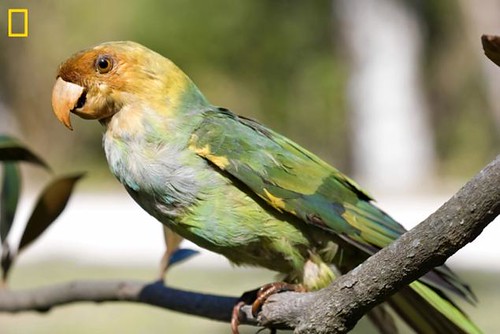Scientists debate ‘DeExtinction’
 Friday, March 15, 2013 at 15:51
Friday, March 15, 2013 at 15:51  The Carolina parakeet (Conuropsis carolinensis) was the only native species of parrot in the eastern United States, having ranged from southern New York to the Gulf of Mexico, and as far west as Wisconsin. Photo by Julie DermanskyIt sounds like a scene from Jurassic Park: molecular biologists, ornithologists, and a bioethicist came together at a private meeting at Harvard Medical School in February of 2012 to discuss bringing back the passenger pigeon.
The Carolina parakeet (Conuropsis carolinensis) was the only native species of parrot in the eastern United States, having ranged from southern New York to the Gulf of Mexico, and as far west as Wisconsin. Photo by Julie DermanskyIt sounds like a scene from Jurassic Park: molecular biologists, ornithologists, and a bioethicist came together at a private meeting at Harvard Medical School in February of 2012 to discuss bringing back the passenger pigeon.
The once-abundant bird was driven into extinction by hunters in 1914. The scientists gathered in Boston, convened by environmentalist Stewart Brand and genome entrepreneur Ryan Phelan, were discussing the technologies they might use to revive the species—and whether such a feat of conservation could and should be done.
Today, that discussion is being aired for a national audience, at a TedX conference convened around the concept of “DeExtinction,” streamed online. It is also the cover story in the April issue of National Geographic.
I spoke with two of the scientists involved in that initial meeting, George Church, the Harvard Medical School geneticist who has developed increasingly sophisticated ways to edit the genome, and Scott V. Edwards, a professor of organismic and evolutionary biology at Harvard University, to get a perspective on the ideas that shaped the conference.
Church said he was tapped for his expertise in technology. He described to the group new tools, many developed in his laboratory, that allowed scientists to very precisely change individual spots in the genome. Such tools made it feasible, Church told them, to take one species and tweak its DNA in the appropriate ways to create a closely-related one that might be extinct.
Edwards provided an ornithological perspective. The bandtailed pigeon, a close relative of the passenger pigeon found on the coast of California and in the foothills, would probably be a good starting place if such an endeavor were to move forward.
That’s not to say scientists were in wholehearted agreement that they should start such a project, or that the passenger pigeon was the best candidate.
Church, for example, said he likes useful things more than iconic demonstrations. He hasn’t signed up for reviving any species, but he’s personally a bit more intrigued by the idea of bringing back mammoths. That interest was sparked in part by a paper published in the journal Science in 2005 that suggests that the “mammoth ecosystem”—in which large herbivores maintained a certain balance of plant life in the Arctic tundra—helped keep the greenhouse gases that fuel global warming in the ground and out of the atmosphere.
“I’m always looking for a practical application,” Church said.
He also said he hoped reviving a species, if it is done, could be similar to the effort to send a man to the moon—a technological feat that inspired a great many young scientists, including himself. That might get people more broadly interested in biology or the genome, and could focus interest not just on bringing back species, but also preserving the ones still here.
“The technology we’re developing for gene therapy could be used for resurrecting diversity, injecting diversity” in species at risk of going extinct, Church said. For example, such techniques could be used to inject genetic diversity that would make Tasmanian devils, a species being ravaged by an infectious fatal cancer, resistant.
Edwards, who participated in the Harvard meeting but not in Friday’s TedX event, noted that there are more extinctions than many people realize in North America alone. Aside from the well-known passenger pigeon, the Carolina Parakeet, the Ivory-billed Woodpecker, and the Bachman’s Warbler are just a few of the species now lost that he mentions when he teaches ornithology.
His concern is that if species revival technology became available, it would detract attention and resources from the critical job of protecting habitat and saving existing species.
“People are going to try to do it,” Edwards said. “I think human curiosity has rarely been checked voluntarily. ... It’s a lot of complex questions as to whether it’s a good or bad thing: People might say humans need to be more cognizant of our actions and we can’t be constantly correcting our rampant destruction of the environment with these quick-fix technologies.”
Only time will tell which efforts, if any, move forward. The scientists had fixated on the passenger pigeon in part because it was nearing the centennial of its extinction, and partly because it is such an iconic bird. John James Audubon described its numbers vividly in his 1837 book, Birds of America:
“The air was literally filled with Pigeons; the light of noon-day was obscured as by an eclipse, the dung fell in spots, not unlike melting flakes of snow; and the continued buzz of wings had a tendency to lull my senses to repose.”
What do you think? Would it be a triumph of conservation biology, a waste of time, or an ethical transgression if scientists were able to revive extinct species and see flocks of pigeons blacken the sky once again?
 Conuropsis carolinensis - Carolina Parakeet | in
Conuropsis carolinensis - Carolina Parakeet | in  Extinction,
Extinction,  Hybrids,
Hybrids,  Research
Research 
